The Cambridge History of China. Vol. 06. Alien Regimes and Border States, 907-1368
Подождите немного. Документ загружается.

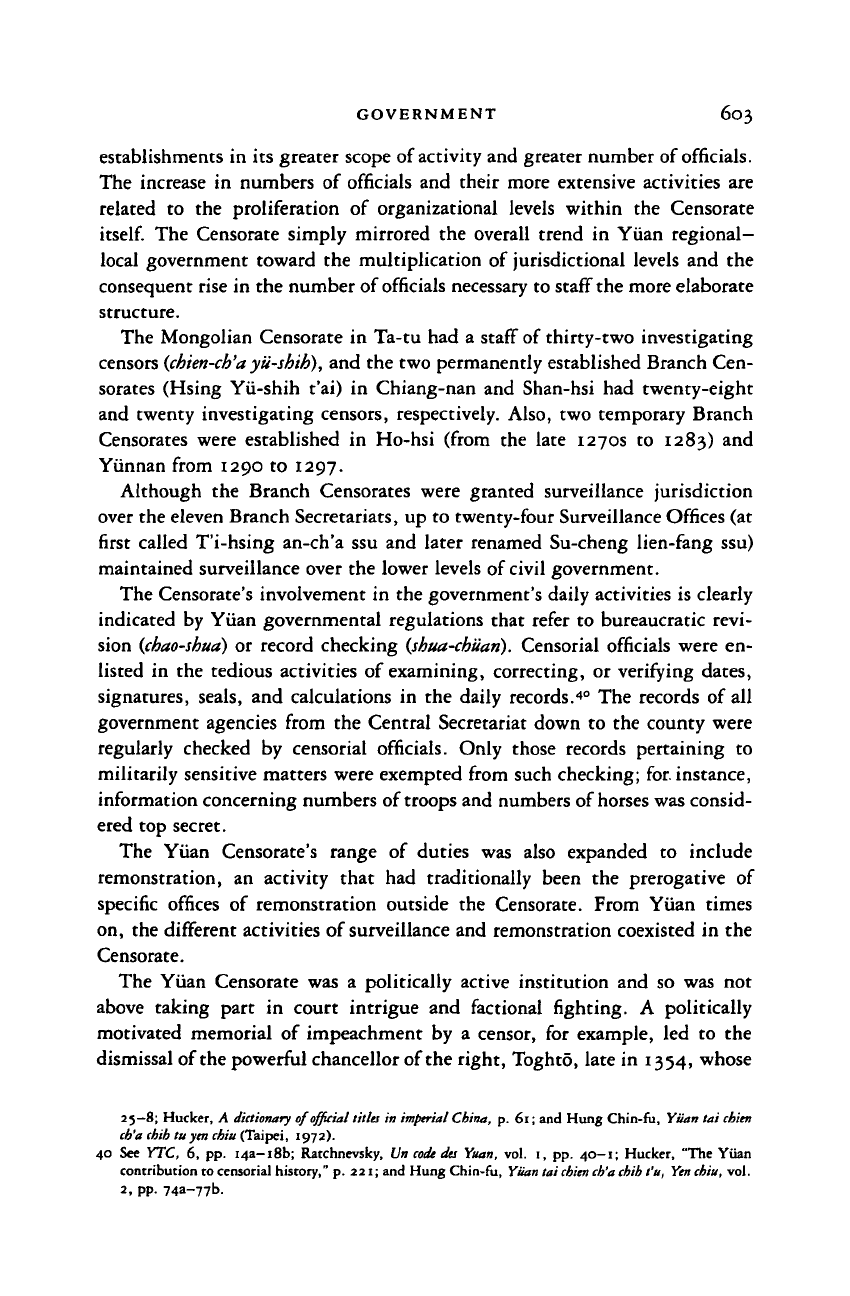
GOVERNMENT
603
establishments in its greater scope of activity and greater number of officials.
The increase in numbers of officials and their more extensive activities are
related to the proliferation of organizational levels within the Censorate
itself.
The Censorate simply mirrored the overall trend in Yuan regional-
local government toward the multiplication of jurisdictional levels and the
consequent rise in the number of officials necessary to staff the more elaborate
structure.
The Mongolian Censorate in Ta-tu had a staff of thirty-two investigating
censors
(chien-ch'a
yu-shih), and the two permanently established Branch Cen-
sorates (Hsing Yu-shih t'ai) in Chiang-nan and Shan-hsi had twenty-eight
and twenty investigating censors, respectively. Also, two temporary Branch
Censorates were established in Ho-hsi (from the late 1270s to 1283) and
Yunnan from 1290 to 1297.
Although the Branch Censorates were granted surveillance jurisdiction
over the eleven Branch Secretariats, up to twenty-four Surveillance Offices (at
first called T'i-hsing an-ch'a ssu and later renamed Su-cheng lien-fang ssu)
maintained surveillance over the lower levels of civil government.
The Censorate's involvement in the government's daily activities is clearly
indicated by Yuan governmental regulations that refer to bureaucratic revi-
sion
(cbao-shua)
or record checking
(shua-chiian).
Censorial officials were en-
listed in the tedious activities of examining, correcting, or verifying dates,
signatures, seals, and calculations in the daily records.4° The records of all
government agencies from the Central Secretariat down to the county were
regularly checked by censorial officials. Only those records pertaining to
militarily sensitive matters were exempted from such checking; for. instance,
information concerning numbers of troops and numbers of horses was consid-
ered top secret.
The Yuan Censorate's range of duties was also expanded to include
remonstration, an activity that had traditionally been the prerogative of
specific offices of remonstration outside the Censorate. From Yuan times
on, the different activities of surveillance and remonstration coexisted in the
Censorate.
The Yuan Censorate was a politically active institution and so was not
above taking part in court intrigue and factional fighting. A politically
motivated memorial of impeachment by a censor, for example, led to the
dismissal of the powerful chancellor of the right, Toghto, late in 1354, whose
25—8;
Hucker, A dictionary of
official
titles in imperial China, p. 61; and Hung Chin-fii, Yuan tai
chien
ch'a
chih
tu
yen
chin (Taipei, 1972).
40 See YTC, 6, pp. 14a—18b; Ratchnevsky, Un
code
da Yuan, vol. 1, pp. 40—1; Hucker, "The Yuan
contribution to censorial history," p. 221; and Hung Chin-fu, Yuan tai
chien ch'a chih
t'u,
Yen
chiu,
vol.
2,
pp. 74a-77b.
Cambridge Histories Online © Cambridge University Press, 2008
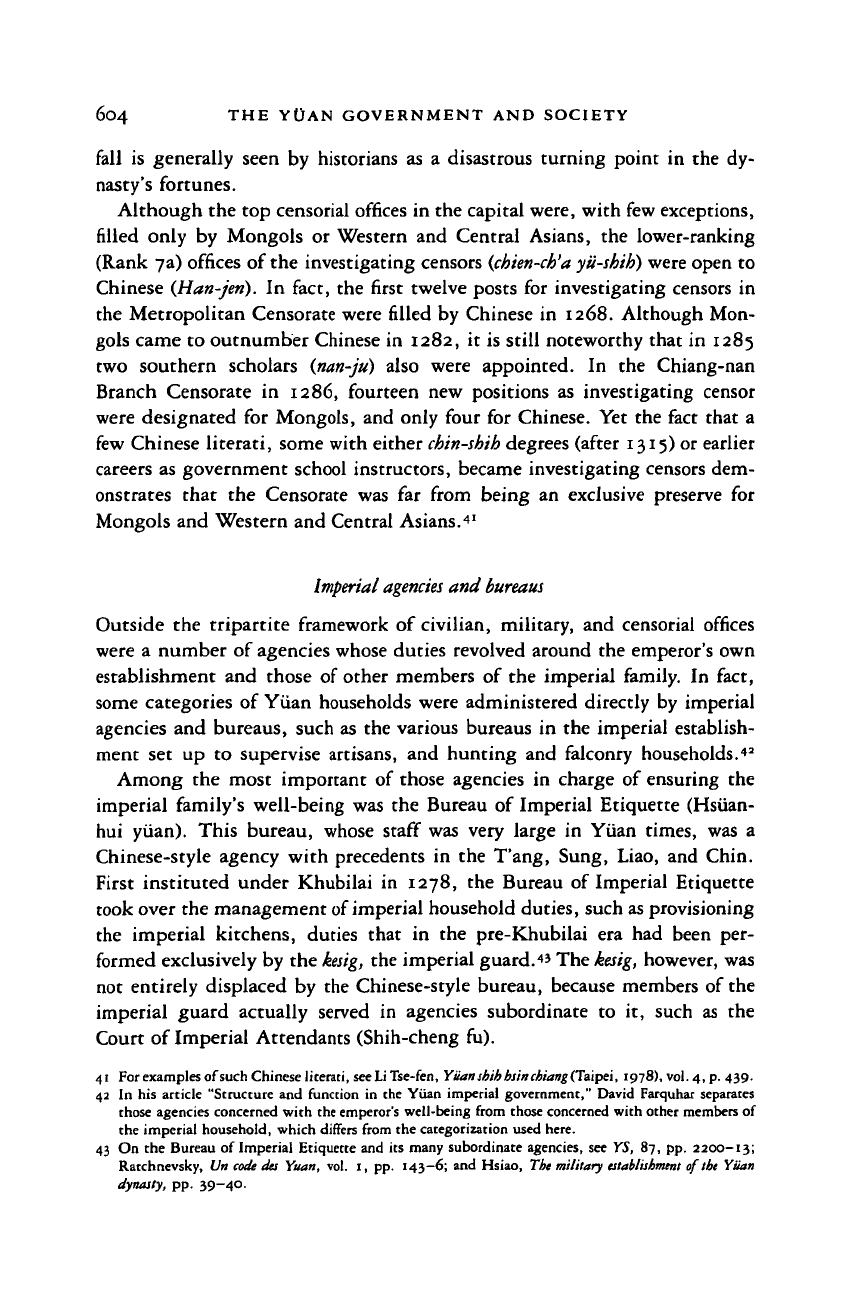
604 THE YOAN GOVERNMENT AND SOCIETY
fall is generally seen by historians as a disastrous turning point in the dy-
nasty's fortunes.
Although the top censorial offices in the capital were, with few exceptions,
filled only by Mongols or Western and Central Asians, the lower-ranking
(Rank 7a) offices of the investigating censors
(chien-ch'a yii-shih)
were open to
Chinese
(Han-jen).
In fact, the first twelve posts for investigating censors in
the Metropolitan Censorate were filled by Chinese in 1268. Although Mon-
gols came to outnumber Chinese in 1282, it is still noteworthy that in 1285
two southern scholars (nan-ju) also were appointed. In the Chiang-nan
Branch Censorate in 1286, fourteen new positions as investigating censor
were designated for Mongols, and only four for Chinese. Yet the fact that a
few Chinese literati, some with either
chin-sbih
degrees (after 1315) or earlier
careers as government school instructors, became investigating censors dem-
onstrates that the Censorate was far from being an exclusive preserve for
Mongols and Western and Central Asians.
4I
Imperial
agencies
and bureaus
Outside the tripartite framework of civilian, military, and censorial offices
were a number of agencies whose duties revolved around the emperor's own
establishment and those of other members of the imperial family. In fact,
some categories of Yuan households were administered directly by imperial
agencies and bureaus, such as the various bureaus in the imperial establish-
ment set up to supervise artisans, and hunting and falconry households.
42
Among the most important of those agencies in charge of ensuring the
imperial family's well-being was the Bureau of Imperial Etiquette (Hsiian-
hui yuan). This bureau, whose staff was very large in Yuan times, was a
Chinese-style agency with precedents in the T'ang, Sung, Liao, and Chin.
First instituted under Khubilai in 1278, the Bureau of Imperial Etiquette
took over the management of imperial household duties, such as provisioning
the imperial kitchens, duties that in the pre-Khubilai era had been per-
formed exclusively by the
kesig,
the imperial guard.
4
' The
kesig,
however, was
not entirely displaced by the Chinese-style bureau, because members of the
imperial guard actually served in agencies subordinate to it, such as the
Court of Imperial Attendants (Shih-cheng fu).
41 For examples ofsuch Chinese literati, see
Li
Tse-fen, Yiian shihbsinchiang(Taipei, 1978), vol. 4, p. 439.
42 In his article "Structure and function in the Yiian imperial government," David Farquhar separates
those agencies concerned with the emperor's well-being from those concerned with other members of
the imperial household, which differs from the categorization used here.
43 On the Bureau of Imperial Etiquette and its many subordinate agencies, see YS, 87, pp. 2200-13;
Ratchnevsky, Un
code
da Yuan, vol. 1, pp. 143-6; and Hsiao, The military
establishment
of
the
Yiian
dynasty, pp. 39—40.
Cambridge Histories Online © Cambridge University Press, 2008
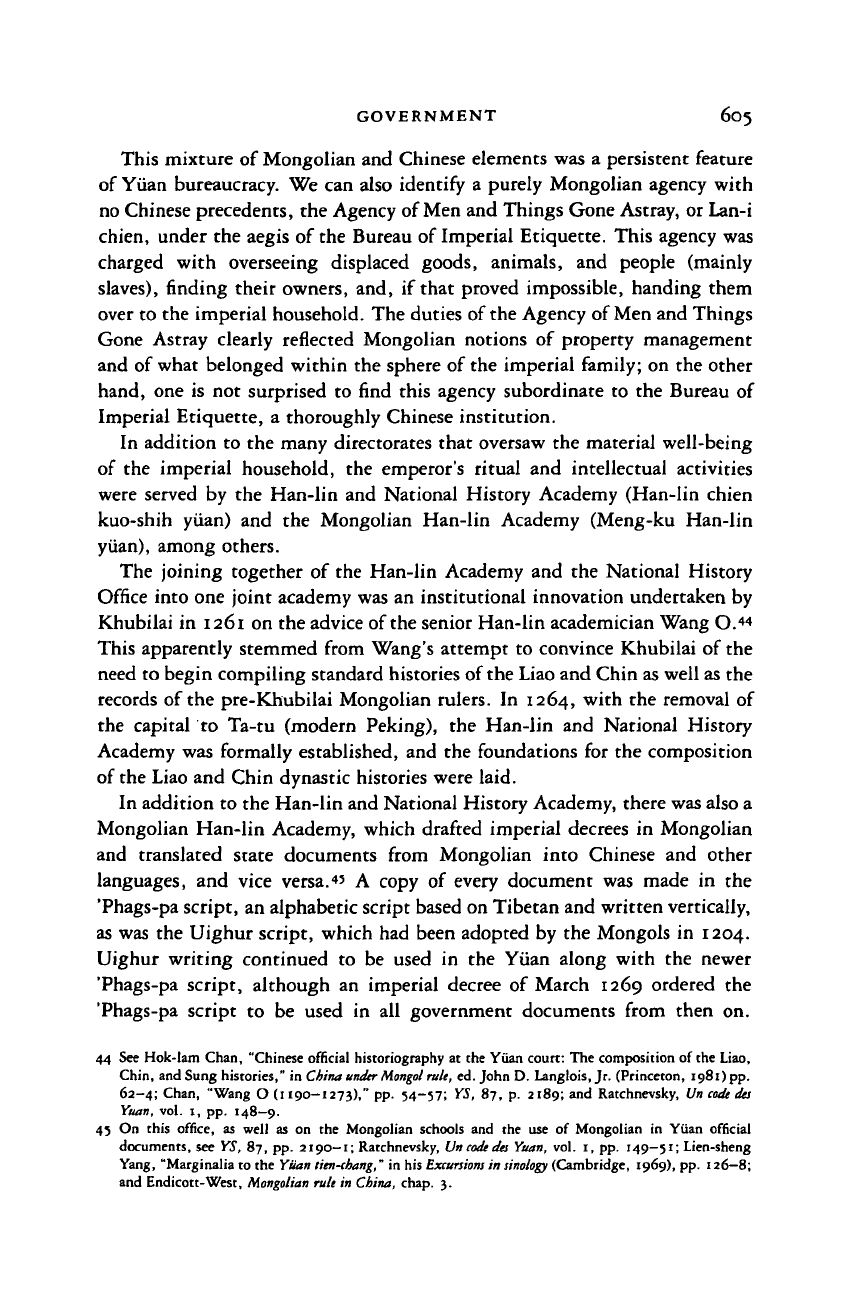
GOVERNMENT 605
This mixture of Mongolian and Chinese elements was a persistent feature
of Yuan bureaucracy. We can also identify a purely Mongolian agency with
no Chinese precedents, the Agency of
Men
and Things Gone Astray, or Lan-i
chien, under the aegis of the Bureau of Imperial Etiquette. This agency was
charged with overseeing displaced goods, animals, and people (mainly
slaves), finding their owners, and, if that proved impossible, handing them
over to the imperial household. The duties of
the
Agency of
Men
and Things
Gone Astray clearly reflected Mongolian notions of property management
and of what belonged within the sphere of the imperial family; on the other
hand, one is not surprised to find this agency subordinate to the Bureau of
Imperial Etiquette, a thoroughly Chinese institution.
In addition to the many directorates that oversaw the material well-being
of the imperial household, the emperor's ritual and intellectual activities
were served by the Han-lin and National History Academy (Han-lin chien
kuo-shih yuan) and the Mongolian Han-lin Academy (Meng-ku Han-lin
yuan),
among others.
The joining together of the Han-lin Academy and the National History
Office into one joint academy was an institutional innovation undertaken by
Khubilai in 1261 on the advice of
the
senior Han-lin academician Wang O.
44
This apparently stemmed from Wang's attempt to convince Khubilai of the
need to begin compiling standard histories of
the
Liao and Chin as well as the
records of the pre-Khubilai Mongolian rulers. In 1264, with the removal of
the capital to Ta-tu (modern Peking), the Han-lin and National History
Academy was formally established, and the foundations for the composition
of the Liao and Chin dynastic histories were laid.
In addition to the Han-lin and National History Academy, there was also a
Mongolian Han-lin Academy, which drafted imperial decrees in Mongolian
and translated state documents from Mongolian into Chinese and other
languages, and vice versa.
4
' A copy of every document was made in the
'Phags-pa script, an alphabetic script based on Tibetan and written vertically,
as was the Uighur script, which had been adopted by the Mongols in 1204.
Uighur writing continued to be used in the Yuan along with the newer
'Phags-pa script, although an imperial decree of March 1269 ordered the
'Phags-pa script to be used in all government documents from then on.
44 See Hok-Iam Chan, "Chinese official historiography at the Yuan court: The composition of the Liao,
Chin, and Sung histories," in China undtr
Mongol
rule,
ed. John D. Langlois, Jr. (Princeton, 1981) pp.
62-4;
Chan, "Wang O (1190—1273)," pp. 54-57; YS, 87, p. 2189; and Ratchnevsky, Vn
code
da
Yuan,
vol. 1, pp. 148—9.
45 On this office, as well as on the Mongolian schools and the use of Mongolian in Yuan official
documents, see YS, 87, pp. 2190—
1;
Ratchnevsky, Uncodedes Yuan, vol. 1, pp. 149—51; Lien-sheng
Yang, "Marginalia to the Yuan
ticn-chang,"
in his
Excursions
in
sinology
(Cambridge, 1969), pp. 126—8;
and Endicott-West, Mongolian rule in China, chap. 3.
Cambridge Histories Online © Cambridge University Press, 2008
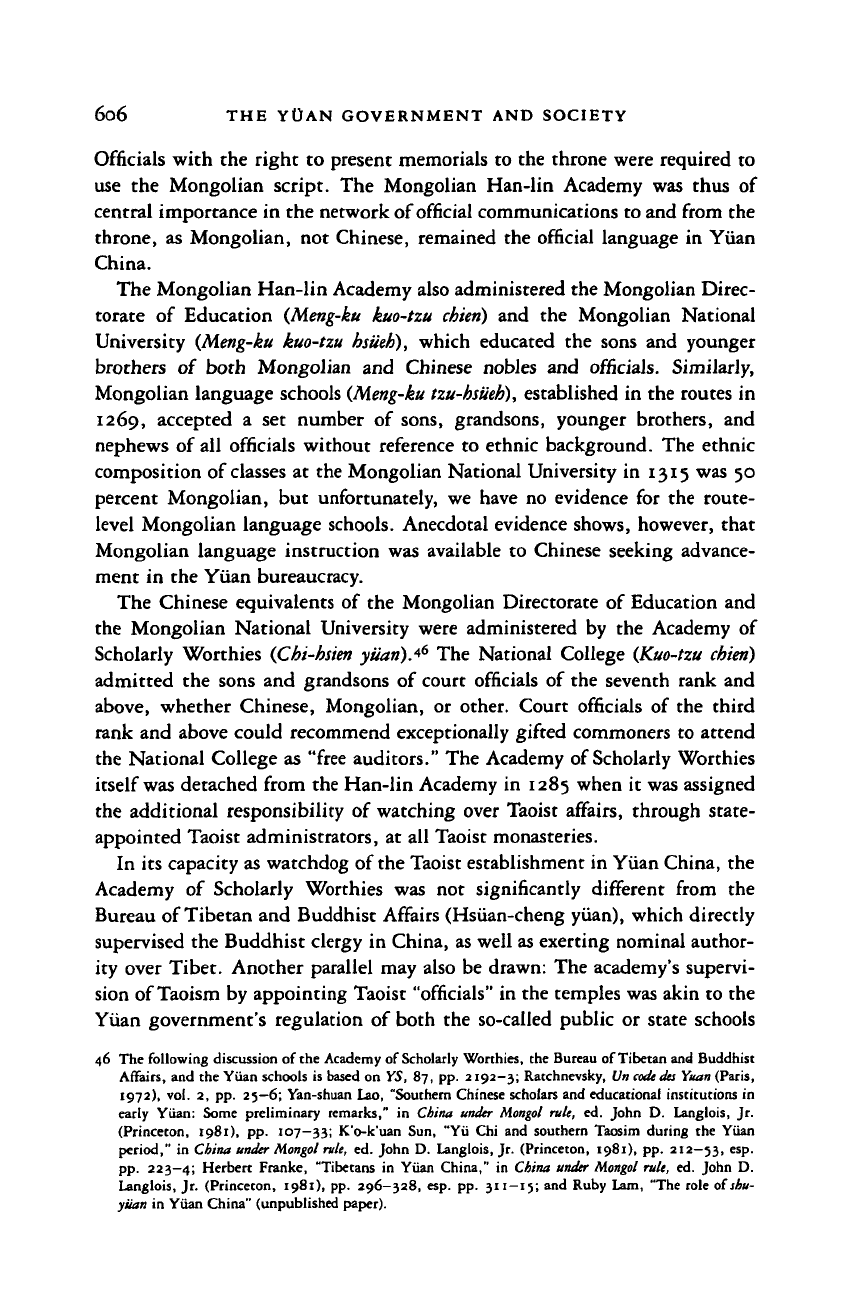
606 THE YOAN GOVERNMENT AND SOCIETY
Officials with the right to present memorials to the throne were required to
use the Mongolian script. The Mongolian Han-lin Academy was thus of
central importance in the network of official communications to and from the
throne, as Mongolian, not Chinese, remained the official language in Yuan
China.
The Mongolian Han-lin Academy also administered the Mongolian Direc-
torate of Education (Meng-ku kuo-tzu
chien)
and the Mongolian National
University
{Meng-ku
kuo-tzu
bsu'eh),
which educated the sons and younger
brothers of both Mongolian and Chinese nobles and officials. Similarly,
Mongolian language schools
{Meng-ku
tzu-hsiieh),
established in the routes in
1269,
accepted a set number of sons, grandsons, younger brothers, and
nephews of all officials without reference to ethnic background. The ethnic
composition of
classes
at the Mongolian National University in 1315 was 50
percent Mongolian, but unfortunately, we have no evidence for the route-
level Mongolian language schools. Anecdotal evidence shows, however, that
Mongolian language instruction was available to Chinese seeking advance-
ment in the Yuan bureaucracy.
The Chinese equivalents of the Mongolian Directorate of Education and
the Mongolian National University were administered by the Academy of
Scholarly Worthies
(Chi-hsien
yuan).*
6
The National College
{Kuo-tzu chien)
admitted the sons and grandsons of court officials of the seventh rank and
above, whether Chinese, Mongolian, or other. Court officials of the third
rank and above could recommend exceptionally gifted commoners to attend
the National College as "free auditors." The Academy of Scholarly Worthies
itself
was
detached from the Han-lin Academy in 1285 when it was assigned
the additional responsibility of watching over Taoist affairs, through state-
appointed Taoist administrators, at all Taoist monasteries.
In its capacity as watchdog of
the
Taoist establishment in Yuan China, the
Academy of Scholarly Worthies was not significantly different from the
Bureau of Tibetan and Buddhist Affairs (Hsiian-cheng yuan), which directly
supervised the Buddhist clergy in China, as well as exerting nominal author-
ity over Tibet. Another parallel may also be drawn: The academy's supervi-
sion of Taoism by appointing Taoist "officials" in the temples was akin to the
Yuan government's regulation of both the so-called public or state schools
46 The following discussion of the Academy of Scholarly Worthies, the Bureau of Tibetan and Buddhist
Affairs, and the Yuan schools is based on YS, 87, pp. 2192-3; Ratchnevsky, Un
code des
Yuan (Paris,
1972),
vol. 2, pp. 25—6; Yan-shuan Lao, "Southern Chinese scholars and educational institutions in
early Yuan: Some preliminary remarks," in China under Mongol rule, ed. John D. Langlois, Jr.
(Princeton, 1981), pp. 107—33; K'o-k'uan Sun, "Yii Chi and southern Taosim during the Yuan
period," in China under Mongol
rule,
ed. John D. Langlois, Jr. (Princeton, 1981), pp. 212-53,
es
P-
pp.
223—4; Herbert Franke, "Tibetans in Yuan China," in China under Mongol rule, ed. John D.
Langlois, Jr. (Princeton, 1981), pp. 296-328, esp. pp. 311—15; and Ruby Lam, "The role of
shu-
yiian in Yuan China" (unpublished paper).
Cambridge Histories Online © Cambridge University Press, 2008
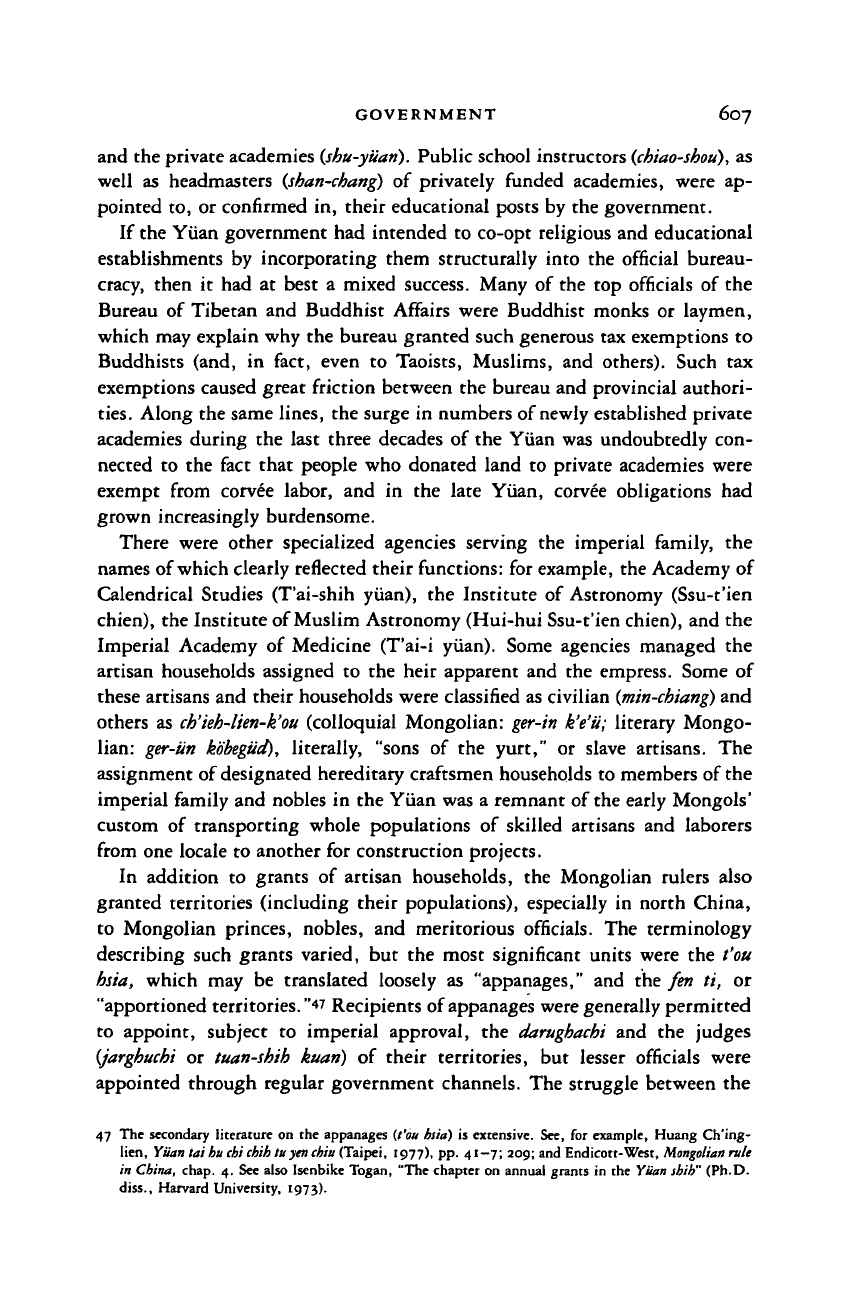
GOVERNMENT 6oj
and the private academies
(shu-yuan).
Public school instructors
(chiao-shou),
as
well as headmasters
{shan-chang)
of privately funded academies, were ap-
pointed to, or confirmed in, their educational posts by the government.
If the Yuan government had intended to co-opt religious and educational
establishments by incorporating them structurally into the official bureau-
cracy, then it had at best a mixed success. Many of the top officials of the
Bureau of Tibetan and Buddhist Affairs were Buddhist monks or laymen,
which may explain why the bureau granted such generous tax exemptions to
Buddhists (and, in fact, even to Taoists, Muslims, and others). Such tax
exemptions caused great friction between the bureau and provincial authori-
ties.
Along the same lines, the surge in numbers of
newly
established private
academies during the last three decades of the Yuan was undoubtedly con-
nected to the fact that people who donated land to private academies were
exempt from corv£e labor, and in the late Yuan, corvee obligations had
grown increasingly burdensome.
There were other specialized agencies serving the imperial family, the
names of which clearly reflected their functions: for example, the Academy of
Calendrical Studies (T'ai-shih yuan), the Institute of Astronomy (Ssu-t'ien
chien),
the Institute of Muslim Astronomy (Hui-hui Ssu-t'ien chien), and the
Imperial Academy of Medicine (T'ai-i yuan). Some agencies managed the
artisan households assigned to the heir apparent and the empress. Some of
these artisans and their households were classified as civilian
(min-chiang)
and
others as
ch'ieh-lien-k'ou
(colloquial Mongolian:
ger-in
k'e'ii;
literary Mongo-
lian:
ger-iin
kobegiid),
literally, "sons of the yurt," or slave artisans. The
assignment of designated hereditary craftsmen households to members of the
imperial family and nobles in the Yuan was a remnant of the early Mongols'
custom of transporting whole populations of skilled artisans and laborers
from one locale to another for construction projects.
In addition to grants of artisan households, the Mongolian rulers also
granted territories (including their populations), especially in north China,
to Mongolian princes, nobles, and meritorious officials. The terminology
describing such grants varied, but the most significant units were the t'ou
hsia, which may be translated loosely as "appanages," and the fen ti, or
"apportioned
territories.
"•"
Recipients of appanages were generally permitted
to appoint, subject to imperial approval, the
darughachi
and the judges
{jarghuchi
or
tuan-shih
kuan) of their territories, but lesser officials were
appointed through regular government channels. The struggle between the
47 The secondary literature on the appanages (t'ou hsia) is extensive. See, for example, Huang Ch'ing-
lien,
Yiian lai hu chi
chih
tuyen
chiu
(Taipei, 1977), pp. 4'—7; 209; and Endicott-West, Mongolian rule
in China, chap. 4. See also Isenbike Togan, "The chapter on annual grants in the Yiian
shih"
(Ph.D.
diss.,
Harvard University, 1973)-
Cambridge Histories Online © Cambridge University Press, 2008
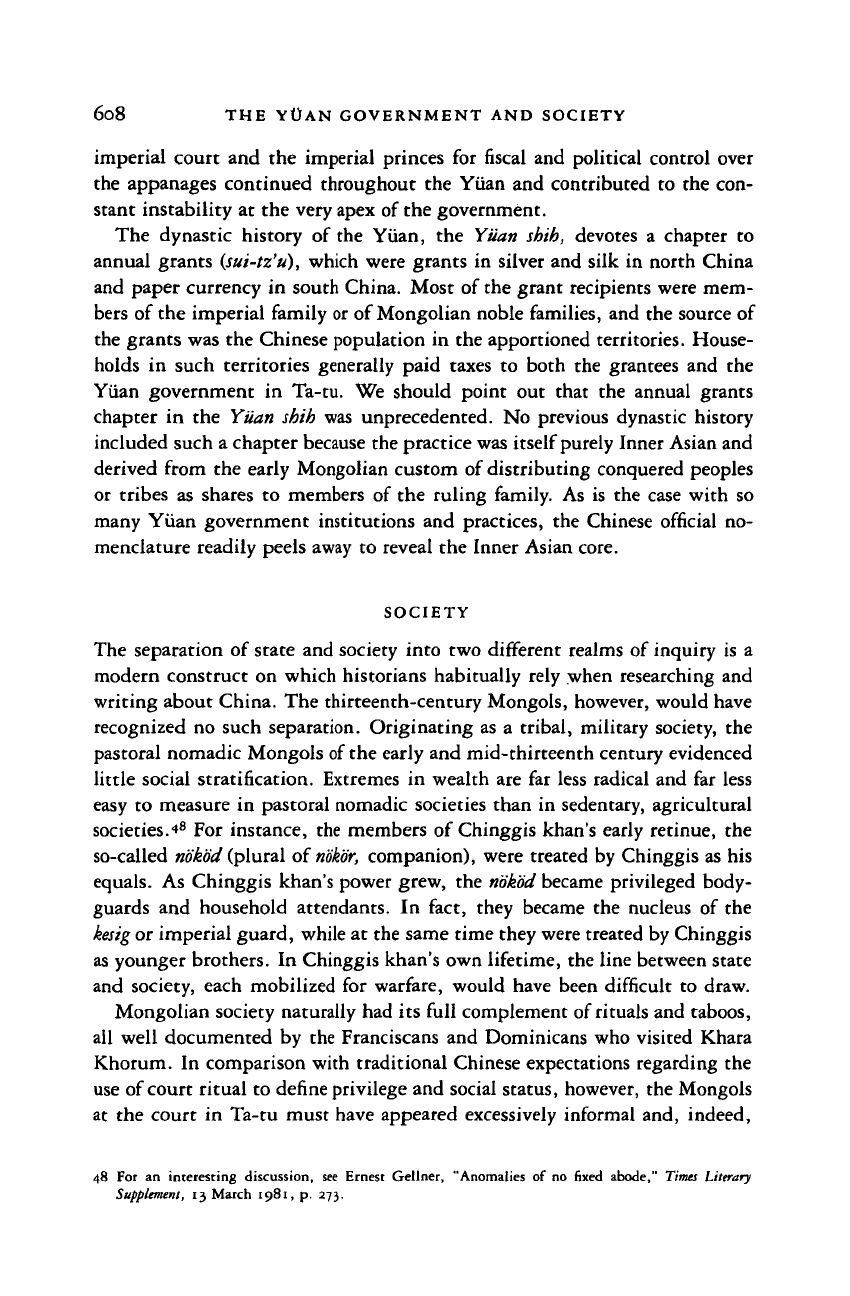
608 THE YOAN GOVERNMENT AND SOCIETY
imperial court and the imperial princes for fiscal and political control over
the appanages continued throughout the Yuan and contributed to the con-
stant instability at the very apex of the government.
The dynastic history of the Yuan, the Yuan shih, devotes a chapter to
annual grants (sui-tz'u), which were grants in silver and silk in north China
and paper currency in south China. Most of the grant recipients were mem-
bers of the imperial family or of Mongolian noble families, and the source of
the grants was the Chinese population in the apportioned territories. House-
holds in such territories generally paid taxes to both the grantees and the
Yiian government in Ta-tu. We should point out that the annual grants
chapter in the Yiian shih was unprecedented. No previous dynastic history
included such a chapter because the practice was itself purely Inner Asian and
derived from the early Mongolian custom of distributing conquered peoples
or tribes as shares to members of the ruling family. As is the case with so
many Yiian government institutions and practices, the Chinese official no-
menclature readily peels away to reveal the Inner Asian core.
SOCIETY
The separation of state and society into two different realms of inquiry is a
modern construct on which historians habitually rely when researching and
writing about China. The thirteenth-century Mongols, however, would have
recognized no such separation. Originating as a tribal, military society, the
pastoral nomadic Mongols of the early and mid-thirteenth century evidenced
little social stratification. Extremes in wealth are far less radical and far less
easy to measure in pastoral nomadic societies than in sedentary, agricultural
societies.4
8
For instance, the members of Chinggis khan's early retinue, the
so-called
nokod
(plural of
niikor,
companion), were treated by Chinggis as his
equals. As Chinggis khan's power grew, the
nokod
became privileged body-
guards and household attendants. In fact, they became the nucleus of the
kesig
or imperial guard, while at the same time they were treated by Chinggis
as younger brothers. In Chinggis khan's own lifetime, the line between state
and society, each mobilized for warfare, would have been difficult to draw.
Mongolian society naturally had its full complement of
rituals
and taboos,
all well documented by the Franciscans and Dominicans who visited Khara
Khorum. In comparison with traditional Chinese expectations regarding the
use of court ritual to define privilege and social status, however, the Mongols
at the court in Ta-tu must have appeared excessively informal and, indeed,
48 For an interesting discussion, see Ernest Gellner, "Anomalies of no fixed abode," Times Literary
Supplement, 13 March 1981, p. 273.
Cambridge Histories Online © Cambridge University Press, 2008
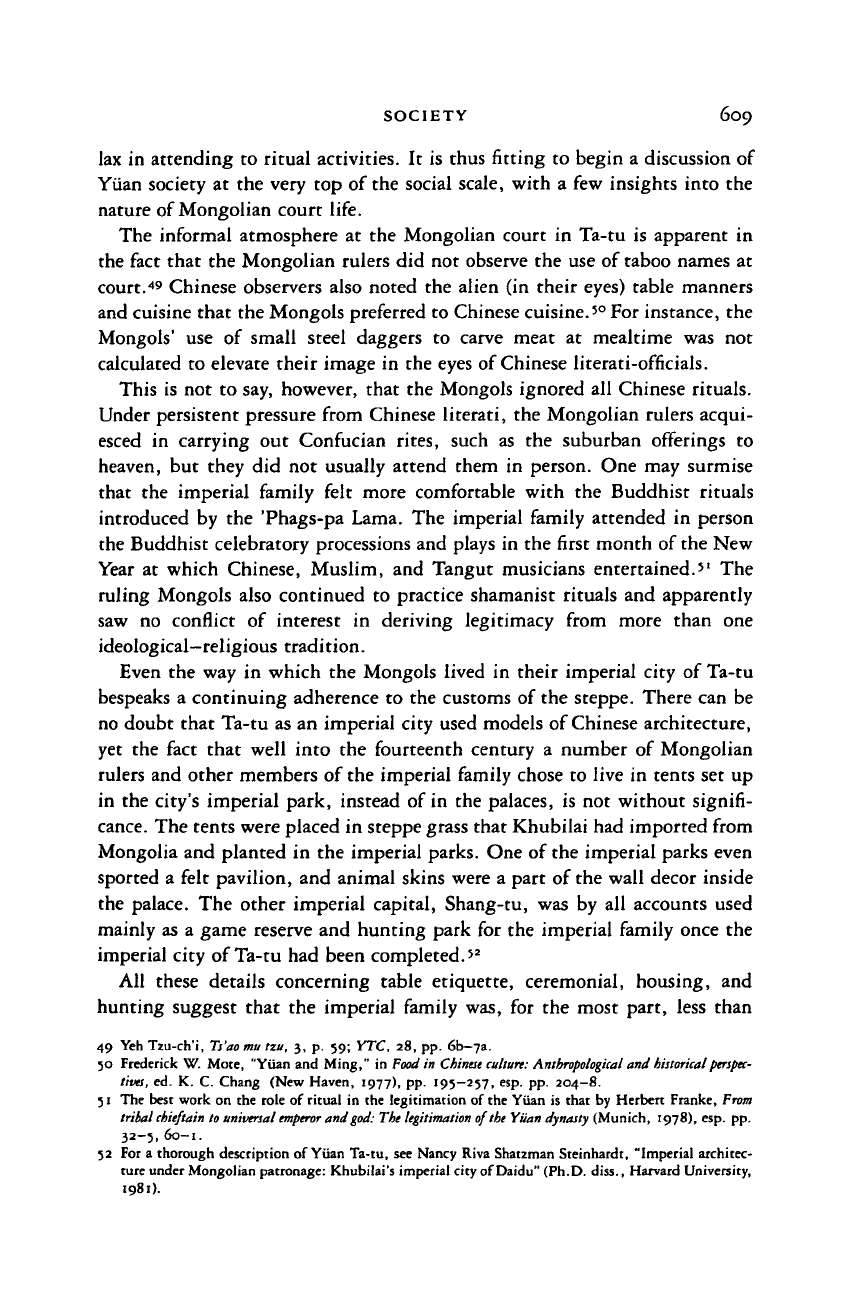
SOCIETY 609
lax in attending to ritual activities. It is thus fitting to begin a discussion of
Yuan society at the very top of the social scale, with a few insights into the
nature of Mongolian court life.
The informal atmosphere at the Mongolian court in Ta-tu is apparent in
the fact that the Mongolian rulers did not observe the use of taboo names at
court.
49
Chinese observers also noted the alien (in their eyes) table manners
and cuisine that the Mongols preferred to Chinese cuisine.
50
For instance, the
Mongols' use of small steel daggers to carve meat at mealtime was not
calculated to elevate their image in the eyes of Chinese literati-officials.
This is not to say, however, that the Mongols ignored all Chinese rituals.
Under persistent pressure from Chinese literati, the Mongolian rulers acqui-
esced in carrying out Confucian rites, such as the suburban offerings to
heaven, but they did not usually attend them in person. One may surmise
that the imperial family felt more comfortable with the Buddhist rituals
introduced by the 'Phags-pa Lama. The imperial family attended in person
the Buddhist celebratory processions and plays in the first month of the New
Year at which Chinese, Muslim, and Tangut musicians entertained.
5
' The
ruling Mongols also continued to practice shamanist rituals and apparently
saw no conflict of interest in deriving legitimacy from more than one
ideological—religious tradition.
Even the way in which the Mongols lived in their imperial city of Ta-tu
bespeaks a continuing adherence to the customs of the steppe. There can be
no doubt that Ta-tu as an imperial city used models of Chinese architecture,
yet the fact that well into the fourteenth century a number of Mongolian
rulers and other members of the imperial family chose to live in tents set up
in the city's imperial park, instead of in the palaces, is not without signifi-
cance. The tents were placed in steppe grass that Khubilai had imported from
Mongolia and planted in the imperial parks. One of the imperial parks even
sported a felt pavilion, and animal skins were a part of the wall decor inside
the palace. The other imperial capital, Shang-tu, was by all accounts used
mainly as a game reserve and hunting park for the imperial family once the
imperial city of Ta-tu had been completed.
52
All these details concerning table etiquette, ceremonial, housing, and
hunting suggest that the imperial family was, for the most part, less than
49 Yeh Tzu-ch'i, Tj'ao mu tzu, 3, p. 59; YTC, 28, pp. fib—7a.
50 Frederick W. Mote, "Yuan and Ming," in
Food
in
Chinese
culture:
Anthropological
and
historical
perspec-
tives, ed. K. C. Chang (New Haven, 1977), pp. 195—257, esp. pp. 204-8.
51 The best work on the role of ritual in the legitimation of the Yuan is that by Herbert Franke, From
tribal
chieftain
to universal
emperor
and god: The legitimation of the Yuan dynasty (Munich, 1978), esp. pp.
32—5,
60-1.
52 For a thorough description of Yuan Ta-tu, see Nancy Riva Shatzman Steinhardt, "Imperial architec-
ture under Mongolian patronage: Khubilai's imperial city of
Daidu"
(Ph.D. diss., Harvard University,
1981).
Cambridge Histories Online © Cambridge University Press, 2008
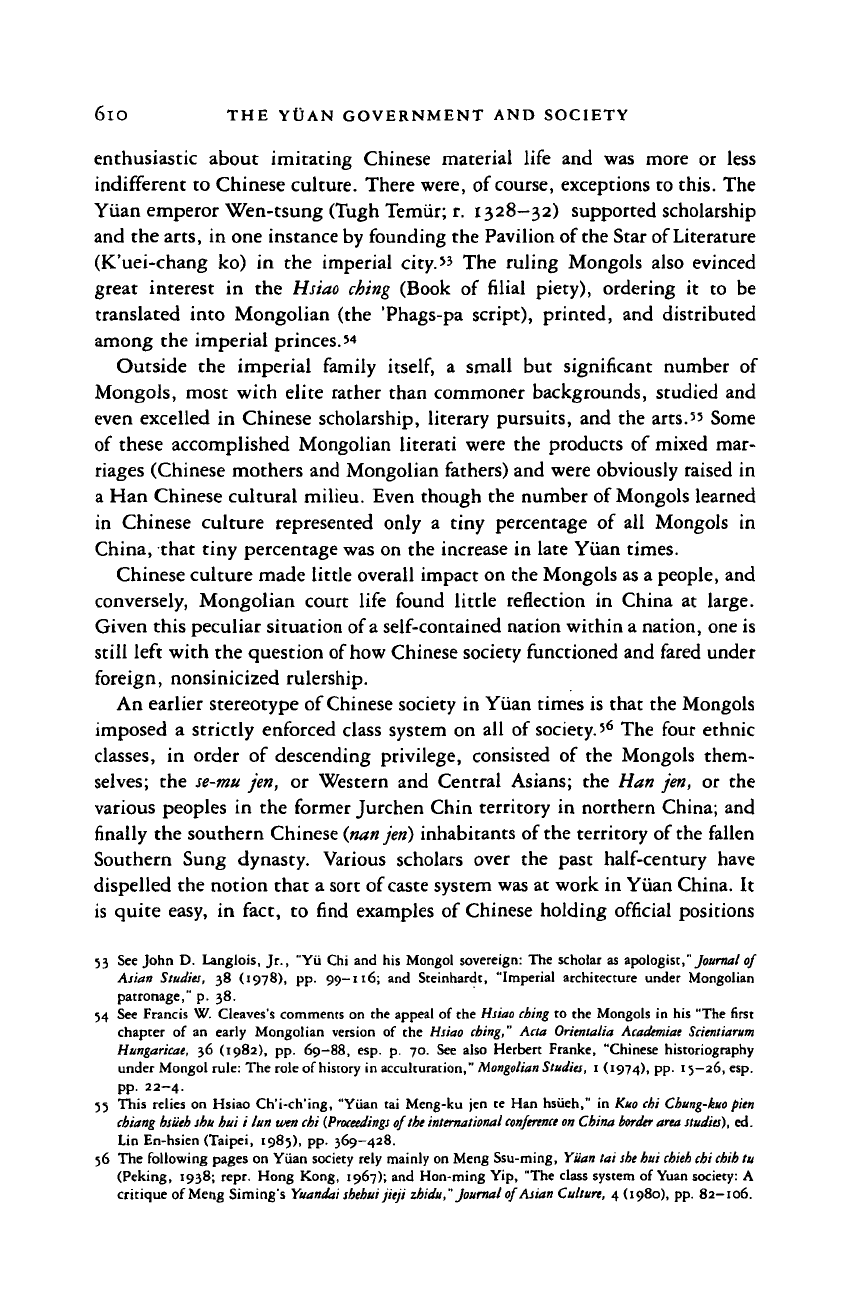
6lO THE YtJAN GOVERNMENT AND SOCIETY
enthusiastic about imitating Chinese material life and was more or less
indifferent to Chinese culture. There were, of
course,
exceptions to this. The
Yuan emperor Wen-tsung (Tugh Temiir; r. 1328-32) supported scholarship
and the arts, in one instance by founding the Pavilion of
the
Star of Literature
(K'uei-chang ko) in the imperial city." The ruling Mongols also evinced
great interest in the Hsiao
ching
(Book of filial piety), ordering it to be
translated into Mongolian (the 'Phags-pa script), printed, and distributed
among the imperial princes.'*
Outside the imperial family
itself,
a small but significant number of
Mongols, most with elite rather than commoner backgrounds, studied and
even excelled in Chinese scholarship, literary pursuits, and the arts.
5
' Some
of these accomplished Mongolian literati were the products of mixed mar-
riages (Chinese mothers and Mongolian fathers) and were obviously raised in
a Han Chinese cultural milieu. Even though the number of
Mongols
learned
in Chinese culture represented only a tiny percentage of all Mongols in
China, that tiny percentage was on the increase in late Yuan times.
Chinese culture made little overall impact on the Mongols as a people, and
conversely, Mongolian court life found little reflection in China at large.
Given this peculiar situation of a self-contained nation within a nation, one is
still left with the question of
how
Chinese society functioned and fared under
foreign, nonsinicized rulership.
An earlier stereotype of
Chinese
society in Yuan times is that the Mongols
imposed a strictly enforced class system on all of
society.
'
6
The four ethnic
classes, in order of descending privilege, consisted of the Mongols them-
selves; the
se-mu
jen, or Western and Central Asians; the Han jen, or the
various peoples in the former Jurchen Chin territory in northern China; and
finally the southern Chinese
{nan jen)
inhabitants of the territory of the fallen
Southern Sung dynasty. Various scholars over the past half-century have
dispelled the notion that a sort of
caste
system was at work in Yuan China. It
is quite easy, in fact, to find examples of Chinese holding official positions
53 See John D. Langlois, Jr., "Yii Chi and his Mongol sovereign: The scholar as apologist," Journal of
Asian Studies, 38 (1978), pp. 99-116; and Steinhardt, "Imperial architecture under Mongolian
patronage," p. 38.
54 See Francis W. Cleaves's comments on the appeal of the Hsiao ding to the Mongols in his "The first
chapter of an early Mongolian version of the Hsiao ching" Acta Oritntalia Academiae Scientiarum
Hungaricae, 36 (1982), pp. 69-88, esp. p. 70. See also Herbert Franke, "Chinese historiography
under Mongol rule: The role of history in acculturation,"
Mongolian
Studies,
1 (1974), pp. 15—26, esp.
pp.
22-4.
55 This relies on Hsiao Ch'i-ch'ing, "Yuan tai Meng-ku jen te Han hsiieh," in Kuo chi
Chung-kuo
pin
chiang
hsiieb
shu hui i lun wen chi
(Proceedings
of the international
conference on
China
border area
studies'),
ed.
Lin En-hsien (Taipei, 1985), pp. 369—428.
56 The following pages on Yuan society rely mainly on Meng Ssu-ming, Yuan tai
she
hui
chieh
chi Mb tu
(Peking, 1938; repr. Hong Kong, 1967); and Hon-ming Yip, "The class system of Yuan society: A
critique of Meng Siming's Yuandai
sbehui
jieji
zhidu,"
Journal of Asian Culture, 4 (1980), pp. 82—106.
Cambridge Histories Online © Cambridge University Press, 2008

SOCIETY
6ll
(such as darughachi) that according to government regulation they were not
entitled to hold. The frequent exceptions to the Yuan regulations, which
attempted to set aside certain offices for specific ethnic groups, indicate a fair
degree of political mobility, although the paths to office were nonetheless not
seen as traditional by Chinese scholars.
This is not to say, however, that the ruling Mongols did not attempt to
construct a differentiated society, in which they themselves and their
preconquest allies
—
the Western and Central Asians
—
would benefit most.
Although demographic realities dictated their employment of Chinese at
virtually all levels of government, the Mongols nonetheless withheld certain
privileges for non-Han ethnic groups.
In regard to ethnic elites, certainly the Turks were the most relied-on and
privileged group after the Mongols themselves in thirteenth- and fourteenth-
century China. This privileged position is easily explained by the special
relationship forged between the various Turkic tribes and the Mongols in the
early thirteenth century.
57
By 1225, the Uighur, Qarluq, Qangli, Qipchaq,
Onggiid, Kereyid, and Naiman (whether the last two were Turkic or Mongo-
lian is debatable) all had submitted to Chinggis khan. The Mongols adapted
the Turkic Uighur vertical script to their spoken language, and the Turks,
many of them Uighur, served as military advisers, secretaries, imperial
tutors,
and civil administrators to the Mongols in the pre-Khubilai period.
In this period, the lingua franca on the eastern steppe was Turkic, not
Persian.
During Khubilai's reign, a large number of Turks continued to be em-
ployed at the court as imperial advisers, tutors to the princes, translators, and
military officers. Khubilai's mother, Sorghaghtani Beki, was, after all, a
Kereyid princess, and Khubilai had grown up surrounded by Turkic advisers.
In post-Khubilai Yuan China, Turks excelled in political intrigue, the most
prominent political personage among them being the Qipchaq El Temiir
(Yen T'ieh-mu-erh, d. 1333).
Among the various groups of
Turks,
the Uighurs were most responsible for
bridging the gap between Chinese and Mongolian culture. Many Uighurs
were translators and interpreters of Chinese and other languages into Mongo-
lian, and several were unquestionably sinicized, as can be seen in their
literary and scholarly achievements in Chinese. The majority of Western and
Central Asians who held chin-shih degrees were Uighurs.
Yet it would be inaccurate to define elites in Yuan China only in terms of
their ethnic origins. Some elite groups seem to have been favored by the
57 See Igor de Rachewiicz, "Turks in China under the Mongols: A preliminary investigation of Turco-
Mongol relations in the 13th and 14th centuries," in China among equals: The Middle Kingdom and its
neighbors, loth—14th
centuries,
ed. Morris Rossabi (Berkeley and Los Angeles, 1983), pp. 281-310.
Cambridge Histories Online © Cambridge University Press, 2008
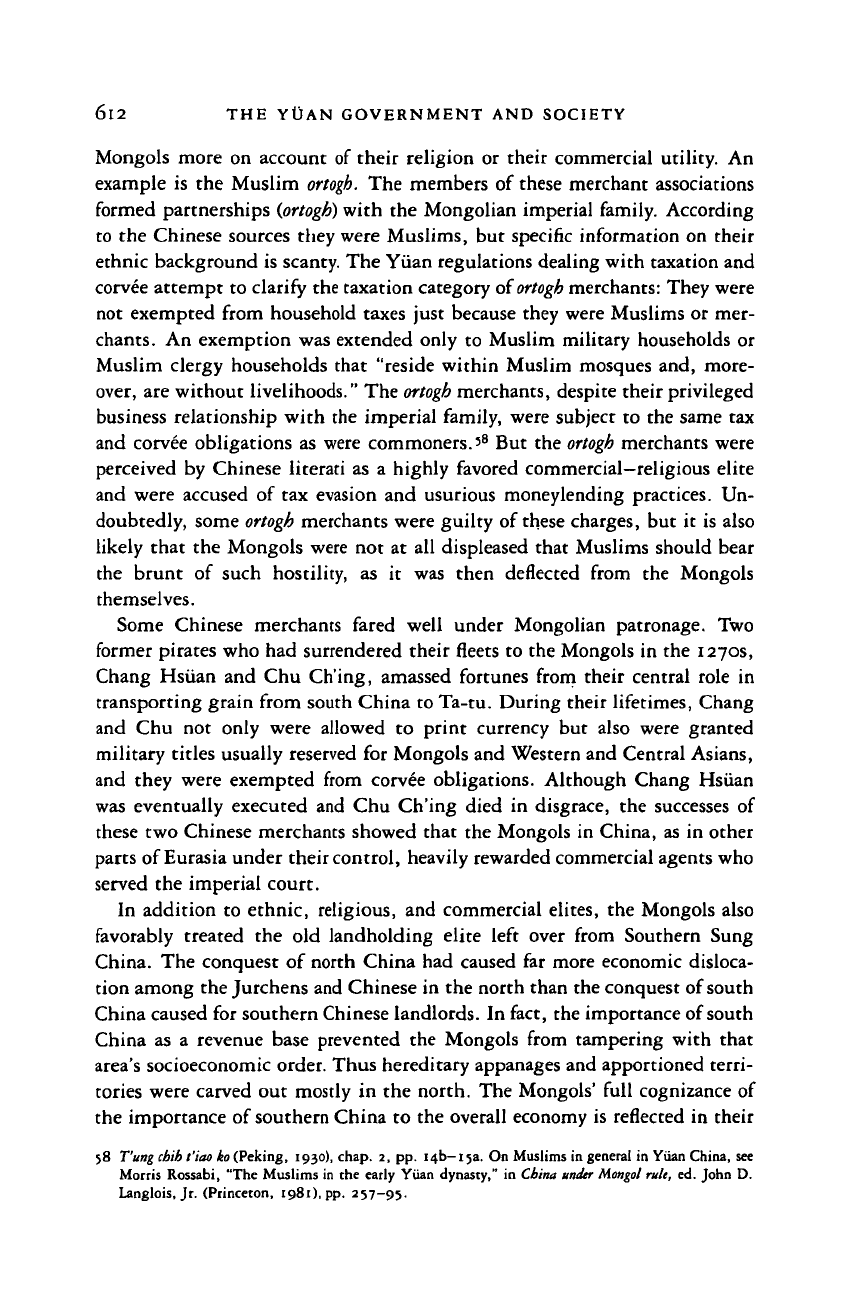
6l2 THE YtJAN GOVERNMENT AND SOCIETY
Mongols more on account of their religion or their commercial utility. An
example is the Muslim
ortogh.
The members of these merchant associations
formed partnerships
{ortogh)
with the Mongolian imperial family. According
to the Chinese sources they were Muslims, but specific information on their
ethnic background is scanty. The Yiian regulations dealing with taxation and
corvee attempt to clarify the taxation category of
ortogh
merchants: They were
not exempted from household taxes just because they were Muslims or mer-
chants. An exemption was extended only to Muslim military households or
Muslim clergy households that "reside within Muslim mosques and, more-
over, are without livelihoods." The
ortogh
merchants, despite their privileged
business relationship with the imperial family, were subject to the same tax
and corvee obligations as were commoners.'
8
But the
ortogh
merchants were
perceived by Chinese literati as a highly favored commercial—religious elite
and were accused of tax evasion and usurious moneylending practices. Un-
doubtedly, some
ortogh
merchants were guilty of these charges, but it is also
likely that the Mongols were not at all displeased that Muslims should bear
the brunt of such hostility, as it was then deflected from the Mongols
themselves.
Some Chinese merchants fared well under Mongolian patronage. Two
former pirates who had surrendered their fleets to the Mongols in the 1270s,
Chang Hsiian and Chu Ch'ing, amassed fortunes from their central role in
transporting grain from south China to Ta-tu. During their lifetimes, Chang
and Chu not only were allowed to print currency but also were granted
military titles usually reserved for Mongols and Western and Central Asians,
and they were exempted from corvee obligations. Although Chang Hsiian
was eventually executed and Chu Ch'ing died in disgrace, the successes of
these two Chinese merchants showed that the Mongols in China, as in other
parts of Eurasia under their control, heavily rewarded commercial agents who
served the imperial court.
In addition to ethnic, religious, and commercial elites, the Mongols also
favorably treated the old landholding elite left over from Southern Sung
China. The conquest of north China had caused far more economic disloca-
tion among the Jurchens and Chinese in the north than the conquest of south
China caused for southern Chinese landlords. In fact, the importance of south
China as a revenue base prevented the Mongols from tampering with that
area's socioeconomic order. Thus hereditary appanages and apportioned terri-
tories were carved out mostly in the north. The Mongols' full cognizance of
the importance of southern China to the overall economy is reflected in their
58
T'ung
chih t'iao ko (Peking, 1930), chap. 2, pp. 14b-15a. On Muslims in general in Yiian China, see
Morris Rossabi, "The Muslims in the early Yuan dynasty," in China under Mongol rule, ed. John D.
Langlois, Jr. (Princeton, 1981), pp. 257-95.
Cambridge Histories Online © Cambridge University Press, 2008
